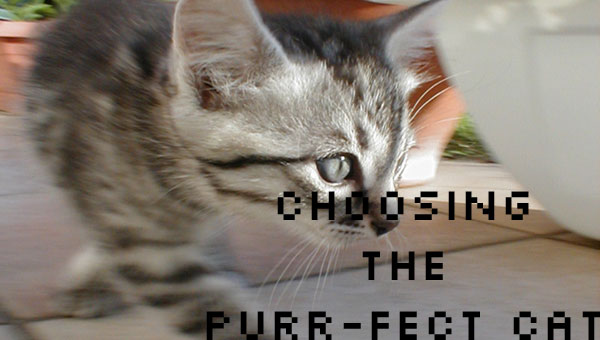
Choosing
a Healthy Animal
Selecting a pet with a good genetic characteristics is one of the most important steps you can take to increase the chances that your cat will have a healthy happy long life. For one thing, that means overriding the temptation to decide on a particular breed just because you like it looks or to pick out the most pitiful looking pet in the litter because it elicits your sympathy. But it's not quite as simple as picking out the liveliest, friendliest and the most inquisitive one you can find either.
Every type of cat (pure or mixed breed) has physical characteristics that invite predictions about its potential well being. Different breed types also have different behavioral tendencies. Just read on to learn how to choose a healthy cat.
The list that follows will alert you to potential problems in various breeds and mixed breeds. But how can you tell if a particular animal is healthy? Here is the checkup list you can sue to pinpoint any congenital defects present. It also helps assess the likelihood of chronic health problems to come.
Coat
What color is the coat? White cats, beautiful as they are, often fall victim to extra problems, such as skin cancers or deafness in white, blue-eyed cats. (Test for deafness by clapping your hands behind the cat's head.)
Nose
Check the nose and jaws. Are they unusually long and pointed or unusually short or pushed in? Odd shapes here should act as a warning against trouble with teeth and gums in additional respiratory problems.
Eyes

Are eyes normal looking? Are they about the same color? Be cautious about the eyes are unusually small or large compared to other felines. Discharges from the eye signal plugged tear ducts because tears and liquids would ordinarily be discharged through the nasal cavity.
Movement
Does the animal move normally? Or does it swing its hips from side to side as it walks? Are legs a normal length and are the front and back legs in the right proportion relative to each other?
Pigmentation
Does the pigmentation over the nose look normal? If not, the animal may be subject to sunburn and skin cancer.
Temperament

Observe the cat carefully for normal temperament. Be wary of cats that seem unusually aggressive, clinging, jealous, fearful, suspicious, hyperactive, noisy or unaware. Whether because of inheritance or environment, such as problems may be difficult to live with and even harder to correct. If you want a playful or affectionate cat, choose the one that responds to your overtures, like rolling her on the back and hold there. See the reactions. If she fights, you should know that she is a hard cat to teach.
Once you have the trust of the cat (and with owner's assistance, if necessary), take a closer look for problem signs.
Skin
Is the coat attractive? Does it look and smell healthy and clean, or is it slightly greasy or thing? Are these reddish patches? Is the skin light pink or off-white in color, pliant and firm or are some areas unusually thin, thick, dry, dark, red or crusty? Is the skin covered with fleas?
Respiration
Does the cat breathe quietly and easily? Raspy, heavy sounds, especially after a little extertion are not good signs.
Ears
Look inside the ears. Check for any signs of inflammation or dark waxy discharge, This could signal a chronic tendency toward ear trouble.Feel around the navel. You are looking for a lump, which could be a sign of a hernia.
Jaws
Are the upper and lower jaws the same size? Do the teeth fit together well? Are the gums pale or inflamed? Is there a red line at the edge of the gums next to the teeth?
These are just a few pointers for selecting a cat for you. Just check the following table to see the behavioral patterns and congenital defects in cats. But this only acts a pointer to selecting a cat. It may be different in other situations.
This is not the opinion of a professional vet or breeder, just a two cents worth of views by an animal lover.

visitors
since 12th July 1998.
Contact me if you have any questions or suggestions.
This site is best viewed with Internet Explorer 6, 800 x 600 pixels & 32-Bit True Colours.